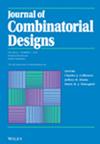Edge balanced star‐hypergraph designs and vertex colorings of path designs
IF 0.5
4区 数学
Q3 MATHEMATICS
引用次数: 0
Abstract
Let K v ( 3 ) = ( X , ℰ ) ${K}_{v}^{(3)}=(X,{\rm{ {\mathcal E} }})$ be the complete hypergraph, uniform of rank 3, defined on a vertex set X = { x 1 , … , x v } $X=\{{x}_{1},\ldots ,{x}_{v}\}$ , so that ℰ ${\rm{ {\mathcal E} }}$ is the set of all triples of X $X$ . Let H ( 3 ) = ( V , D ) ${H}^{(3)}=(V,{\mathscr{D}})$ be a subhypergraph of K v ( 3 ) ${K}_{v}^{(3)}$ , which means that V ⊆ X $V\subseteq X$ and D ⊆ ℰ ${\mathscr{D}}\subseteq {\rm{ {\mathcal E} }}$ . We call 3‐edges the triples of V $V$ contained in the family D ${\mathscr{D}}$ and edges the pairs of V $V$ contained in the 3‐edges of D ${\mathscr{D}}$ , that we denote by [ x , y ] $[x,y]$ . A H ( 3 ) ${H}^{(3)}$ ‐design Σ ${\rm{\Sigma }}$ is called edge balanced if for any x , y ∈ X $x,y\in X$ , x ≠ y $x\ne y$ , the number of blocks of Σ ${\rm{\Sigma }}$ containing the edge [ x , y ] $[x,y]$ is constant. In this paper, we consider the star hypergraph S ( 3 ) ( 2 , m + 2 ) ${S}^{(3)}(2,m+2)$ , which is a hypergraph with m $m$ 3‐edges such that all of them have an edge in common. We completely determine the spectrum of edge balanced S ( 3 ) ( 2 , m + 2 ) ${S}^{(3)}(2,m+2)$ ‐designs for any m ≥ 2 $m\ge 2$ , that is, the set of the orders v $v$ for which such a design exists. Then we consider the case m = 2 $m=2$ and we denote the hypergraph S ( 3 ) ( 2 , 4 ) ${S}^{(3)}(2,4)$ by P ( 3 ) ( 2 , 4 ) ${P}^{(3)}(2,4)$ . Starting from any edge‐balanced S ( 3 ) 2 , v + 4 3 ${S}^{(3)}\left(2,\frac{v+4}{3}\right)$ , with v ≡ 2 mod 3 $v\equiv 2\,\mathrm{mod}\,3$ sufficiently big, for any p ∈ N $p\in {\mathbb{N}}$ , v 2 ≤ p ≤ v $\unicode{x02308}\frac{v}{2}\unicode{x02309}\le p\le v$ , we construct a P ( 3 ) ( 2 , 4 ) ${P}^{(3)}(2,4)$ ‐design of order 2 v $2v$ with feasible set { 2 , 3 } ∪ [ p , v ] $\{2,3\}\cup [p,v]$ , in the context of proper vertex colorings such that no block is either monochromatic or polychromatic.边缘平衡星超图设计和路径设计的顶点着色
设K v (3) = (X, e) ${K}_{v}^{(3)}=(X,{\rm{ {\mathcal E} }})$是在顶点集X = X {1,…,X v}$X=\{{x}_{1},\ldots ,{x}_{v}\}$上定义的秩为3的完全超图,使得e e ${\rm{ {\mathcal E} }}$是X的所有三元组的集合$X$。设H (3) = (V, D) ${H}^{(3)}=(V,{\mathscr{D}})$是K V (3) ${K}_{v}^{(3)}$的一个子超图,即V⊥X $V\subseteq X$、D⊥${\mathscr{D}}\subseteq {\rm{ {\mathcal E} }}$。我们称3条边为包含在D族${\mathscr{D}}$中的V $V$三元组,称边为包含在D ${\mathscr{D}}$的3条边中的V $V$对,我们用[x, y] $[x,y]$表示。如果对于任意x, y∈x $x,y\in X$, x≠y $x\ne y$,则H (3) ${H}^{(3)}$‐design Σ ${\rm{\Sigma }}$被称为边平衡,Σ ${\rm{\Sigma }}$包含边[x, y] $[x,y]$的块数是恒定的。本文考虑星型超图S (3) (2, m + 2) ${S}^{(3)}(2,m+2)$,它是一个有m $m$ 3‐条边且所有边都有一条共同边的超图。我们完全确定了任意m≥2 $m\ge 2$的边缘平衡S (3) (2, m + 2) ${S}^{(3)}(2,m+2)$‐设计的谱,即存在这种设计的v $v$阶集。然后我们考虑m = 2 $m=2$的情况,我们用P (3) (2,4) ${P}^{(3)}(2,4)$表示超图S (3) (2,4) ${S}^{(3)}(2,4)$。从任意边平衡的S (3) 2, v + 4 3 ${S}^{(3)}\left(2,\frac{v+4}{3}\right)$,且v≡2 mod 3 $v\equiv 2\,\mathrm{mod}\,3$足够大,对于任意p∈N $p\in {\mathbb{N}}$, v 2≤p≤v $\unicode{x02308}\frac{v}{2}\unicode{x02309}\le p\le v$,我们构造了一个具有可行集2,3∪[p, v] $\{2,3\}\cup [p,v]$的p (3) (2,4) ${P}^{(3)}(2,4)$‐2{ v }$2v$阶设计,在适当顶点着色的情况下,使得没有块是单色的或多色的。
本文章由计算机程序翻译,如有差异,请以英文原文为准。
求助全文
约1分钟内获得全文
求助全文
来源期刊
CiteScore
1.60
自引率
14.30%
发文量
55
审稿时长
>12 weeks
期刊介绍:
The Journal of Combinatorial Designs is an international journal devoted to the timely publication of the most influential papers in the area of combinatorial design theory. All topics in design theory, and in which design theory has important applications, are covered, including:
block designs, t-designs, pairwise balanced designs and group divisible designs
Latin squares, quasigroups, and related algebras
computational methods in design theory
construction methods
applications in computer science, experimental design theory, and coding theory
graph decompositions, factorizations, and design-theoretic techniques in graph theory and extremal combinatorics
finite geometry and its relation with design theory.
algebraic aspects of design theory.
Researchers and scientists can depend on the Journal of Combinatorial Designs for the most recent developments in this rapidly growing field, and to provide a forum for both theoretical research and applications. All papers appearing in the Journal of Combinatorial Designs are carefully peer refereed.

 求助内容:
求助内容: 应助结果提醒方式:
应助结果提醒方式:


